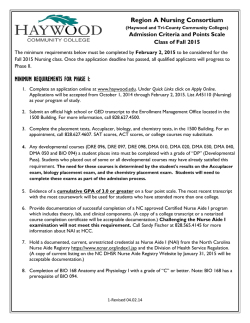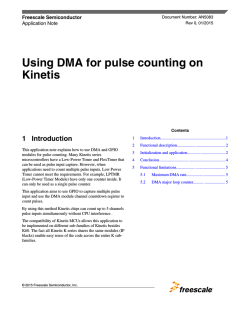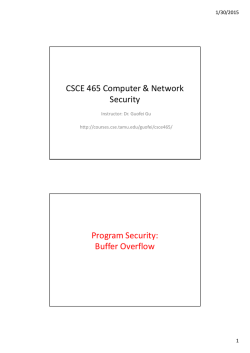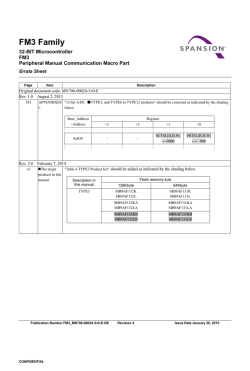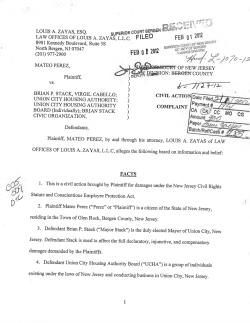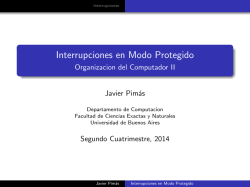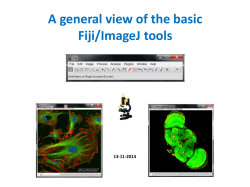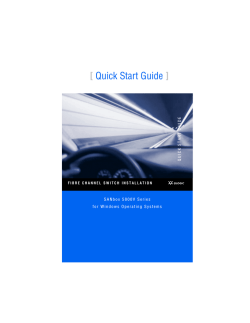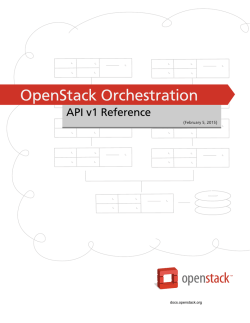
Formation STM32 + FreeRTOS + LwIP/EmWin: This - Ac6
Formation STM32 + FreeRTOS + LwIP/EmWin: This course covers the STM32 ARM-based MCU family, the FreeRTOS Real Time OS, the LWIP TCP/IP Stack and/or the EmWin GUI Stack - Programmation: Temps réel STG - STM32 + FreeRTOS + LwIP/EmWin This course covers the STM32 ARM-based MCU family, the FreeRTOS Real Time OS, the LWIP TCP/IP Stack and/or the EmWin GUI Stack Objectives Get an overview on the Cortex-M architecture Understand the Cortex-M software implementation and debug Learn how to deal with interrupts Get an overview on STM32F2 architecture Describing the units which are interconnected to other modules, such as clocking, interrupt controller and DMA controller Describing some independent I/O modules like the ADC and GPIOs Getting started with the ST Drivers to program STM32 peripherals (The STM32Cube Library or ST Standard Peripheral Library) Understand the FreeRTOS architecture Discover the various FreeRTOS services and APIs Learn how to develop and debug FreeRTOS applications Getting started with the lwIP TCP/IP stack (Describing the STM32 Ethernet Controller, having a look on porting, describing the parameterizing, and developping application based on UDP and TCP protocols) (not available for STM32F0 family) For specific sessions, the EmWin GUI library can also be covered (instead of the LwIP TCP/IP stack for example) This course can be based on STM32F4xx, STM32F2xx, STM32F1xx, or STM32F0xx families Course environment Convenient course material with space for taking notes Example code, labs and solutions A STM32-Eval Board (like the STM3240G-Eval Board (Cortex-M4)) with the SW4STM32 IDE (Keil, IAR or Trace32 (Lauterbach) can also be used) Prerequisites Familiarity with C concepts and programming targeting the embedded world Basic knowledge of embedded processors Basic knowledge of multi-task scheduling Plan First Day STG - STM32 + FreeRTOS + LwIP/EmWin 01/29/15 Cortex-M Architecture Overview V7-M Architecture Overview Core Architecture Harvard Architecture, I-Code, D-Code and System Bus Write Buffer Bit-Banding Registers (Two stacks pointers) States Different Running-modes and Privileged Levels System Control Block Systick Timer MPU Overview Programming Alignment and Endianness CMSIS Library Exception / Interrupt Mechanism Overview Vector Table Interrut entry and return Overview Tail-Chaining Pre-emption (Nesting) NVIC Integrated Interrupt Controller Exception Priority Management Fault escalation Debug Interface Exercice : Becoming familiar with the IDE and clarifying the boot sequence Exercice : Changing the use stack pointer and the privilege mode with the CMSIS library Exercice : Interrupt Management on Cortex-M core (put in evidence tail-chaining/nesting) STM32F2 MCUs Architecture Overview ARM core based architecture Description of STM32FX SoC architecture Clarifying the internal data and instruction paths: Bus Matrix, AHB-lite interconnect, peripheral buses, AHB-to-APB bridges, DMAs Memory Organization Flash memory read interface Adaptive Real-Time memory accelerator, instruction prefetch queue and branch cache Sector and mass erase Concurrent access to RAM blocks SoC mapping Flash Programming methods Boot Configuration Second Day Reset, Power and Clocking Reset Reset sources Boot configuration, physical remap Embedded boot loader Clocking Clock sources, HSI, HSE, LSI, LSE Integrated PLLs STG - STM32 + FreeRTOS + LwIP/EmWin Clock outputs Clock security system Power control Power supplies, integrated regulator Battery backup domain, backup SRAM Independent A/D converter supply and reference voltage Power supply supervisor Brownout reset Programmable voltage detector Low power modes Entering a low power mode, WFI vs WFE Sleep mode Stop mode Standby mode Exercice : Initialize the system at different frequencies Exercice : Enter Low power modes and wake up (optional) ST Firmware Library Description DMA Dual AHB master bus architecture, one dedicated to memory accesses and one dedicated to peripheral accesses 8 streams for each DMA controller, up to 8 channels (requests) per stream Priorities between DMA stream requests FIFO structure Independent source and destination transfer width Circular buffer management Double buffer mode DMA1 and DMA2 request mapping Exercice : Initialize memory-to-memory DMA transfers Communicate with the world external to the chip Power pins Pinout Pin Muxing, alternate functions GPIO module Configuring a GPIO Speed selection Locking mechanism Analog function Integrated pull-up / pull-down I/O pin multiplexer and mapping System configuration controller I/O compensation cell External Interrupts / Wakeup lines selection Ethernet PHY interface selection External Interrupts Exercice : Configure an external Interrupt (optional) 12-bit Analog-to-Digital Converter 12-bit, 10-bit, 8-bit or 6-bit configurable resolution Regular channel group vs Injected channel group Single and continuous conversion modes Scan mode for automatic conversion of channel 0 to channel ‘n’ 01/29/15 STG - STM32 + FreeRTOS + LwIP/EmWin External trigger option with configurable polarity for both regular and injected conversions Discontinuous mode Analog watchdog’s guarded area Dual/Triple mode (on devices with 2 ADCs or more) Configurable delay between conversions in Dual/Triple interleaved mode DMA request generation during regular channel conversion Exercice : Get voltage from the potentiometer using, DMA transfer generation Timers Overview (optional) Advanced-control timers TIM1 and TIM8 16-bit up, down, up/down auto-reload counter; 16-bit programmable prescaler Input Capture, Output Compare, PWM generation, One-pulse mode Synchronization circuit/ Controlling Timers external signals / Interconnecting several timers Interrupt/DMA generation Real Time Clock Independent BCD timer/counter; 16-bit programmable prescaler Daylight saving compensation programmable by software Two programmable alarms with interrupt function Automatic wakeup unit Reference clock detection / Digital calibration circuit Tamper detection Exercice : Input Capture, Output Compare, PWM generation, Interrupt and DMA transfer generation (optional) Exercice : Configuring the RTC (optional) Third Day The FreeRTOS source code Introduction to FreeRTOS The FreeRTOS architecture and features Getting FreeRTOS source code Files and directories structure Data types and coding style Naming conventions FreeRTOS on the Cortex/M processors Task Management Prioritized Pre-emptive Scheduling / Co-operative scheduling The Task life-cycle Task Functions Creating tasks Using the task parameter The Task State Machine Deleting tasks Task Priorities Assigning task priorities Changing task priorities The idle task Idle task hook Blocking a task for a specific delay Editing the FreeRTOSConfig.h header file Suspending a task The Kernel Structures Overview FreeRTOS Debug Capabilities (Hook, Trace) Exercice : Managing tasks, get trace information 01/29/15 STG - STM32 + FreeRTOS + LwIP/EmWin Memory Management Memory management algorithms Best fit / First Fit FreeRTOS-provided memory allocation schemes Choosing the heap_x.c file depending on the application Adding an application-specific memory allocator Checking remaining free memory Stack monitoring Dimensioning Stack and Heap Fourth Day Queue Management Blocking on queue Reads Blocking on queue Writes Queue Creation Sending on a queue Receiving from a queue Sending compound types Transfering large data Queue Set Overview/ Blocking on multiple objects Semaphores and Events Introduction Exercice : Synchronizing and communicating between tasks through queues Resource Management Conflict examples Mutual exclusion Critical sections Disabling the interrupts Suspending (locking) the scheduler Mutexes Mutual exclusion scenario API functions for Mutexes Recursive Mutexes Priority inversion Priority inheritance Deadlock Gatekeeper tasks Exercice : Implement mutual exclusion between different tasks Interrupt Management Binary semaphore used for interrupt synchronization API function for binary semaphore Counting semaphores Using queues within an ISR Interrupt Nesting Interrupts on Cortex-M Low Power Support Exercice : Synchronize Interrupts with tasks 01/29/15 STG - STM32 + FreeRTOS + LwIP/EmWin Fifth Day Software Timer The Timer Daemon Task Timer Configuration One-shot / Auto-reload Timer Software Timer API Exercice : Implement Software Timers FreeRTOS MPU User Mode and Privilege Mode Access Permission Attributes Defining an MPU region Creating a non-privileged task Linker configuration Practical Usage Tips STM32 Fast Ethernet Controller Overview Architecture of the MAC Connection to PHY, RMII / MII Transmit and receive FIFO threshold setting Multicast and unicast address filtering Management interface Buffer and Buffer Descriptor organization Low level Drivers for STM32 LwIP TCP/IP Stack Presentation Overview Buffer and memory management LwIP configuration options Network interfaces MAC and IP address settings IP processing UDP processing TCP processing Interfacing the stack Application Program Interface (API) Standalone Netconn and BSD socket library STM32/FreeRTOS Port Overview Exercice : TCP/UDP echo server netconn Exercice : ST HTTP server (optional) EmWin GUI Stack Presentation (optional) Library and package description How to use the library Configuration Initialization Core functions Developing a multi-task application with EmWin 01/29/15 STG - STM32 + FreeRTOS + LwIP/EmWin 01/29/15 Working with some widgets (as the Windows, Buttons, Multipage, Image, ListBox, CheckBox) Using the EmWinGuiBuilder software Exercice : Getting started with the emWin stack Renseignements pratiques Durée : 5 jours Prix : 2100 € HT SARL au capital de 138600 € - SIRET 449 597 103 00026 - RCS Nanterre - NAF 722C - Centre de Formation : 19, rue Pierre Curie - 92400 Courbevoie Siège social et administration : 21, rue Pierre Curie - 92400 Courbevoie - Tél. 01 41 16 80 10 - Fax. 01 41 16 07 78 Dernière mise à jour du site: Thu Jan 29 10:17:18 2015 http://www.ac6-formation.com/
© Copyright 2025
